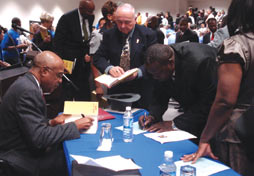By Gabrielle Traylor/reporter
“Behind this mask I am someone real …”
“ The Mask,” a song written to single-parent women who lived in vacant fields and under bridges in Puerto Rico, began a SE Campus discussion of anorexia and bulimia last week.
Sharon Cutts, a recovered bulimic, presented Beauty Undressed—The Key to Life during the SE Campus health fair Oct. 31.
Cutts said she wrote the song to inspire the Puerto Rican women to feel free enough to tell her they were not having such great days. This openness soon led into a discussion of eating disorders in America.
Cutts’ eating disorder started when she was 3. She said she started coping with her stress by refusing to eat.
Then in sixth grade, her best friend said Cutts was too fat for them to be friends in middle school. That comment began her progress into bulimia.
She said she realized she was full fledged into an eating disorder when her mother went from saying “you should lose some weight” to “you need to gain some weight.”
Cutts mentioned many celebrities throughout the discussion. Kate Bosworth was the cover of the Power Point presentation she used with her speech. Cutts then moved to a slide featuring Miss Piggy, who she said helped her through her own struggle with anorexia.
Jessica Simpson, Cutts said, also struggled with weight loss. Even after reaching 101 pounds, her record label told her she needed to lose more weight.
But Simpson, Cutts said, put her foot down saying, “Enough is enough. I know a lot of fans who see me think I am beautiful with my curves.”
Detailing the history of modeling led Cutts to discuss the vast number of people with eating disorders. Models were once curvaceous women who brought more to the eye than just designs, she said.
When department stores conducted surveys, their shoppers said they thought more about the models than the clothes. Therefore, department stores began to look for smaller models with no curves to get the attention back on the clothing items.
Discussing the importance of seeing beauty in one’s faults, Cutts asked if anyone woke up, looked in the mirror and said to themselves, “Wow I look great this morning!”
When one person raised her hand, Cutts said, “We need to talk after this presentation. I need to take some pointers from you.”
Cutts told the story of a beautiful rose garden interrupted by a dandelion weed. She said she wanted to pull the dandelion to keep the rose garden beautiful, but then her neighbors invited her into their backyard, where she saw a beautiful dandelion garden.
Like the dandelions and roses, Cutts said, differences make everyone beautiful.
When people were asked whether they would like to be built like Heidi Klum and live to be 40 or be morbidly obese but live to be 100, 81 percent chose to look like Heidi Klum while 19 percent chose to be obese.
Behaviorism, Cutts said, also plays a big role in eating disorders.
The study of behaviorism was developed by John B. Watson in the 1930s. He taught marketers to sell their images. Apparently, his own family was not exempt because his children and his grandchildren attempted suicide, and some of them succeeded.
Eight to 10 million people in America and 70 percent worldwide suffer from bulimia or anorexia, Cutts said. Early detection and inversion are key.
Cutts said there are four levels of recovery: emotional, physical, spiritual and mental. In order to fully recover from eating disorders, she said, one needs a team consisting of a physician/dentist, psychologist, psychiatrist, dietician/nutritionist and a mentor. But most people can afford only two of the five parts of the team needed to beat eating disorders.
Without treatment, Cutts said, up to 20 percent of sufferers die, but with treatment, the mortality rate drops 2-3 percent.
Cutts said she finally has learned to live with her 15-year disorder.
“ When my brain says I want to starve today, I say, ‘You can’t do this, but you can do any of these five things; walk the dog, feed the parakeet, watch a movie, go for a walk or read a book.’”
Cutts said it took her eight years for sustained recovery.
She ended the presentation with a slide of Paula Abdul who once said, “I’ve learned how to turn my mind around from my enemy to my ally.”
To learn more about eating disorders and ways to help someone with a disorder, visit Cutts’ Web site at www.The-Key-To-Life.com.





























